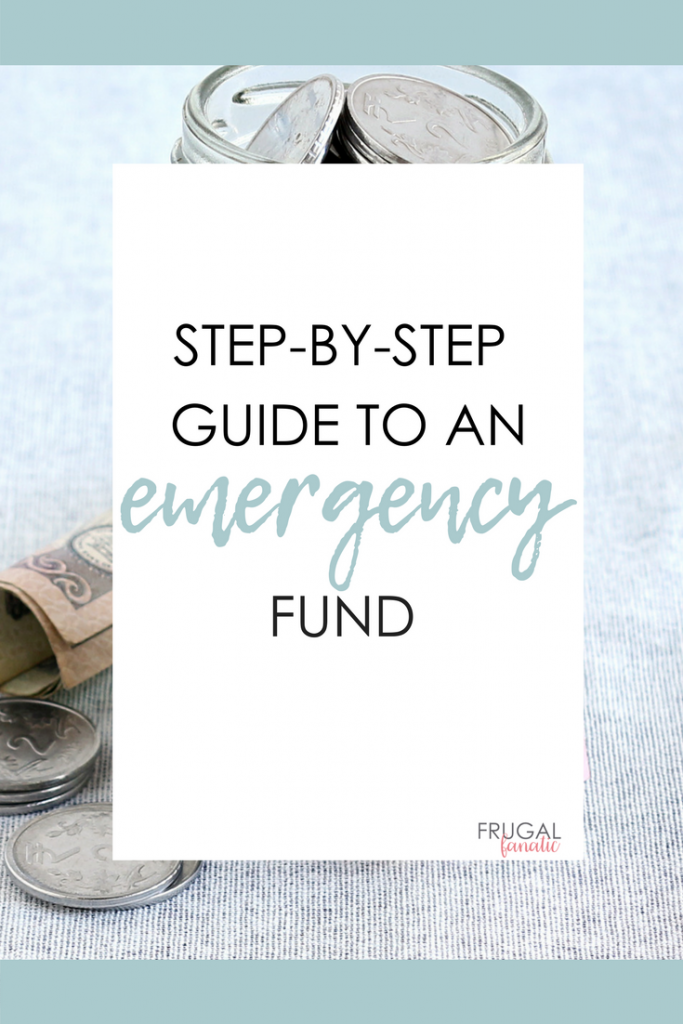Step-by-step guide to building an emergency fund
Building an emergency fund might sound like something scary, but trust me once you have plan it won’t be as intimidating. This step-by-step guide to building an emergency fund will walk you through the process so that you can start to build an account for you and your family.
Step By Step Guide To Building An Emergency Fund
 To take control of your financial security, you need to start with a solid emergency fund. Most debt that is not associated with a mortgage, or vehicle purchase is due to using credit in an emergency situation. By creating an emergency fund, you protect yourself from incurring extra debt that will bog down your financial situation. An emergency fund is simply a savings account that to use in the case of an emergency. For example, if your water heater breaks and you need to purchase a new one, then you can pull the money from your emergency fund rather than putting it onto a credit card and accumulating more debt. If you are just starting to save money this should be a top priority otherwise you will just continue your debt cycle.Determine how much you want in your emergency fund. If you do not have money saved you should start by building an emergency fund of $500-$1,000 first. There is a difference between a short-term emergency fund and a long-term emergency fund. A short-term will help you to cover smaller expenses like a water heater or car repairs, where-as a long-term emergency fund will needed be in place for things like job loss.Evaluate your existing budget. To begin building an emergency fund, you have to start with your income and expenses. An evaluation of your current budget is a must. {Related: Free Monthly Budget}Break down your income and expenses to find any holes. That extra income can easily be pushed toward your emergency fund. This is the time where you look at your budget and determine if you are living within your means, or if you are struggling to get by. If you are living within your means already, you may have excess to automatically funnel toward your emergency fund. If you are struggling to make ends meet, then you will need to follow the steps below more carefully so that you can start to save money to put away into your emergency fund. Automatically push funds to your emergency fund. One of the simplest ways to build an emergency fund is to make it happen directly through your employer. Setting up an automatic deposit into a savings or emergency fund is a simple way to mindlessly begin saving money. This will prevent you from using that money.Contact your HR department and request to have a specific amount or percentage of your pay redirected from your regular pay. If you work for yourself, you can do the same by having select amounts from regular clients put directly into a special savings account instead of your regular working account.This is like paying yourself first. I am sure you have said to yourself in the past, “I will save $50 from this paycheck,” but then end up spending it all. By putting the money away first you no longer have the option of spending it so that you can build up that emergency fund.{Related: Paying yourself first}Create an excess in your budget. When evaluating your budget, you may find things that are unnecessary expenses. We've all been found to spend a bit more on takeout coffee, or meals out for dinner one time or another. It's time to create an excess in your budget by eliminating the extra expenses. Take the time to go over your expenses carefully to weed out anything unnecessary. This includes the usual things like cutting back on entertainment expenses, eliminating takeout and splurges, or cutting down subscriptions like cable or satellite television. Get diligent about the little fees. If you don't have an excess income to add to your emergency fund, then the little things are going to be the way to go. There are tons of small fees that add up fast in your daily life. While we have already mentioned creating an excess by eliminating unnecessary expenses, there are some hidden fees involved with regular expenses that add up as well that you should consider. This is the time to start calling all of the companies that you have subscriptions or contracts with to lower fees. From your vehicle insurance to your phone company, there are always small fees that can be removed. Simply take some time to contact these companies and services to go over every detail to determine what can be eliminated. Increase income streams. If you are still struggling to find a source of money to funnel into your emergency fund, it is time to increase your income streams. This varies greatly for every individual and family, but there are tons of options. We have many great ideas on ways to make money from home that can fit into a few hours a week to a full time job. There are also many extra or second jobs you may consider in your community. Ultimately, an emergency fund requires income to create, so you may need to choose an additional income stream. {Related: 20 Ways to make more money}This is a great place to begin in a step by step guide to building an emergency fund. The biggest focus behind an emergency fund is to create a surplus that will become a back up when your regular income is not sufficient. What steps have you taken to create an emergency fund?
To take control of your financial security, you need to start with a solid emergency fund. Most debt that is not associated with a mortgage, or vehicle purchase is due to using credit in an emergency situation. By creating an emergency fund, you protect yourself from incurring extra debt that will bog down your financial situation. An emergency fund is simply a savings account that to use in the case of an emergency. For example, if your water heater breaks and you need to purchase a new one, then you can pull the money from your emergency fund rather than putting it onto a credit card and accumulating more debt. If you are just starting to save money this should be a top priority otherwise you will just continue your debt cycle.Determine how much you want in your emergency fund. If you do not have money saved you should start by building an emergency fund of $500-$1,000 first. There is a difference between a short-term emergency fund and a long-term emergency fund. A short-term will help you to cover smaller expenses like a water heater or car repairs, where-as a long-term emergency fund will needed be in place for things like job loss.Evaluate your existing budget. To begin building an emergency fund, you have to start with your income and expenses. An evaluation of your current budget is a must. {Related: Free Monthly Budget}Break down your income and expenses to find any holes. That extra income can easily be pushed toward your emergency fund. This is the time where you look at your budget and determine if you are living within your means, or if you are struggling to get by. If you are living within your means already, you may have excess to automatically funnel toward your emergency fund. If you are struggling to make ends meet, then you will need to follow the steps below more carefully so that you can start to save money to put away into your emergency fund. Automatically push funds to your emergency fund. One of the simplest ways to build an emergency fund is to make it happen directly through your employer. Setting up an automatic deposit into a savings or emergency fund is a simple way to mindlessly begin saving money. This will prevent you from using that money.Contact your HR department and request to have a specific amount or percentage of your pay redirected from your regular pay. If you work for yourself, you can do the same by having select amounts from regular clients put directly into a special savings account instead of your regular working account.This is like paying yourself first. I am sure you have said to yourself in the past, “I will save $50 from this paycheck,” but then end up spending it all. By putting the money away first you no longer have the option of spending it so that you can build up that emergency fund.{Related: Paying yourself first}Create an excess in your budget. When evaluating your budget, you may find things that are unnecessary expenses. We've all been found to spend a bit more on takeout coffee, or meals out for dinner one time or another. It's time to create an excess in your budget by eliminating the extra expenses. Take the time to go over your expenses carefully to weed out anything unnecessary. This includes the usual things like cutting back on entertainment expenses, eliminating takeout and splurges, or cutting down subscriptions like cable or satellite television. Get diligent about the little fees. If you don't have an excess income to add to your emergency fund, then the little things are going to be the way to go. There are tons of small fees that add up fast in your daily life. While we have already mentioned creating an excess by eliminating unnecessary expenses, there are some hidden fees involved with regular expenses that add up as well that you should consider. This is the time to start calling all of the companies that you have subscriptions or contracts with to lower fees. From your vehicle insurance to your phone company, there are always small fees that can be removed. Simply take some time to contact these companies and services to go over every detail to determine what can be eliminated. Increase income streams. If you are still struggling to find a source of money to funnel into your emergency fund, it is time to increase your income streams. This varies greatly for every individual and family, but there are tons of options. We have many great ideas on ways to make money from home that can fit into a few hours a week to a full time job. There are also many extra or second jobs you may consider in your community. Ultimately, an emergency fund requires income to create, so you may need to choose an additional income stream. {Related: 20 Ways to make more money}This is a great place to begin in a step by step guide to building an emergency fund. The biggest focus behind an emergency fund is to create a surplus that will become a back up when your regular income is not sufficient. What steps have you taken to create an emergency fund?
